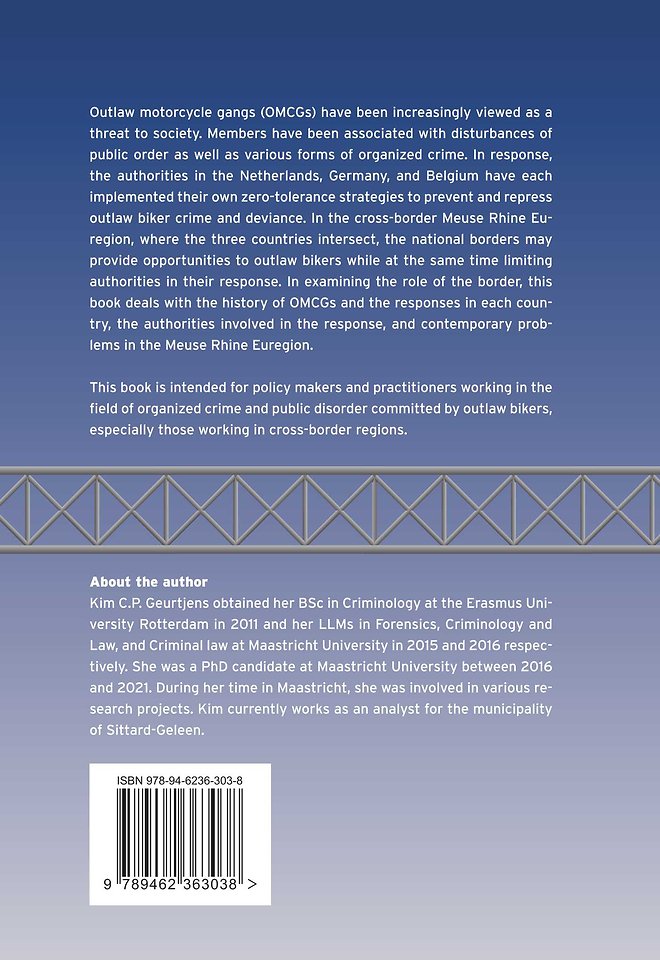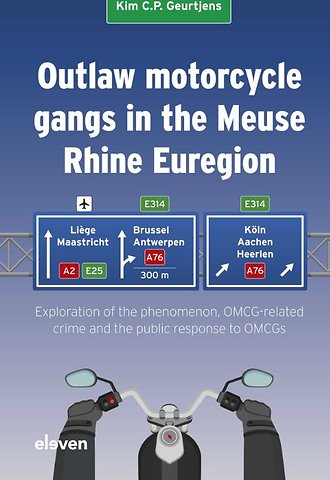



Kim C.P. Geurtjens obtained her BSc in Criminology at the Erasmus University Rotterdam in 2011 and her LLMs in Forensics, Criminology and Law, and Criminal law at Maastricht University in 2015 and 2016 respectively. She was a PhD candidate at Maastricht University between 2016 and 2021. During her time in Maastricht, she was involved in various research projects.
Meer over Kim C.P. GeurtjensOutlaw motorcycle gangs in the Meuse Rhine Euregion
Exploration of the phenomenon, OMCG-related crime and the public response to OMCGs
Gebonden Engels 2022 1e druk 9789462363038Samenvatting
Outlaw motorcycle gangs (OMCGs) have been increasingly viewed as a threat to society. Members have been associated with disturbances of public order as well as various forms of organized crime. In response, the authorities in the Netherlands, Germany, and Belgium have each implemented their own zero-tolerance strategies to prevent and repress outlaw biker crime and deviance.
In the cross-border Meuse Rhine Euregion, where the three countries intersect, the national borders may provide opportunities to outlaw bikers while at the same time limiting authorities in their response. In examining the role of the border, this book deals with the history of OMCGs and the responses in each country, the authorities involved in the response, and contemporary problems in the Meuse Rhine Euregion.
This book is intended for policy makers and practitioners working in the field of organized crime and public disorder committed by outlaw bikers, especially those working in cross-border regions.
Trefwoorden
Specificaties
Lezersrecensies
Inhoudsopgave
1 Introduction 3
1.1 General introduction 3
1.2 Characteristics and criminality of OMCGs 5
1.2.1 OMCG definitions 5
1.2.2 OMCG-related criminality 7
1.2.3 Social clubs or criminal gangs? 8
1.2.4 International events with local consequences and vice versa 10
1.3 Role of the national border for criminal activities 11
1.3.1 The internal EU market and free movement 13
1.3.2 The difficulty of cross-border cooperation between authorities 15
1.4 Towards an administrative approach of OMCGs in the Meuse Rhine Euregion? 16
1.4.1 The European context 16
1.4.2 The administrative approach of OMCGs in the Meuse Rhine Euregion 17
1.5 Research questions 19
1.5.1 Demarcation of the scope of the research 19
1.6 Outline of this book 21
1.6.1 Part 1 21
1.6.2 Part 2 21
1.6.3 Part 3 23
1.6.4 Part 4 23
2 Research approach & methodology 25
2.1 Introduction 25
2.2 Theoretical lens for crime opportunity and opportunity reduction 27
2.2.1 Crime opportunity 27
2.2.2 Opportunity reduction 29
2.3 Data collection and analysis 31
2.3.1 Review of literature and policy documents 31
2.3.2 Expert meetings, court hearings and explorative interviews 33
2.3.3 Media analysis of regional newspaper articles 35
2.3.4 Focused semi-structured interviews 37
2.3.5 Case study 39
2.4 Ethical considerations 41
2.5 Limitations and reflections 42
Part 2 OMCGs,OMCG-related crime,the public response toOMCG-related crime and their development in the Netherlands, Germany, and Belgium
3 From bikersto gangsters – On the rise of OMCGs and the development of repressive approaches in the Netherlands, Germany, and Belgium from the 1970s until 2010 47
3.1 Introduction 47
3.2 The origin, characteristic features, and expansion of OMCGs 48
3.3 From the 1970s until the mid-1980s 53
3.3.1 Bikers riding out together 53
3.3.2 Regulated tolerance 55
3.4 From mid-1980s until 2000 56
3.4.1 Growth and internationalization of clubs 56
3.4.2 Laissez-faire attitude 58
3.5 From 2000 to 2010 60
3.5.1 Internal and external conflicts 60
3.5.2 Repressive stance 62
3.6 Role and meaning of national borders 64
3.7 Discussion and conclusion 65
4 Towards a zero-tolerance strategy against OMCGs – In the Netherlands, Germany, and Belgium, and itsimplicationsin the Meuse Rhine Euregion from 2010 until 2016 69
4.1 Introduction 69
4.2 Rapid Growth of OMCGs and continued feuds 70
4.2.1 The Netherlands 71
4.2.2 Germany 72
4.2.3 Belgium 73
4.3 Zero-tolerance and responsibilization strategy 73
4.3.1 The Netherlands 74
4.3.2 Germany 76
4.3.3 Belgium 77
4.4 The zero-tolerance strategy in light of situational crime prevention 78
4.5 The situation in the Meuse Rhine Euregion: a pro-active government against OMCG-related crime 79
4.5.1 Categorizing the criminal activities associated to OMCGs in the Meuse Rhine Euregion 82
4.5.2 Categorizing the measures under the zero-tolerance strategy 85
4.6 Discussion and conclusion 89
5 Authoritiesinvolved in the public response to OMCGsin the MeuseRhine Euregion 93
5.1 Introduction 93
5.2 Authorities involved in the fight against OMCGs in theNetherlands 94
5.2.1 The public prosecutor’s office 94
5.2.2 The police 95
5.2.3 The public administration 97
5.2.4 The multi-agency approach 98
5.3 Authorities involved in the fight against OMCGs in Belgium 100
5.3.1 The public prosecutor’s office 100
5.3.2 The police 101
5.3.3 The public administration 103
5.3.4 The multi-agency approach 104
5.4 Authorities involved in the fight against OMCGs in Germany 104
5.4.1 The public prosecutor’s office 105
5.4.2 The police 105
5.4.3 The public administration 107
5.4.4 The multi-agency approach 108
5.5 Fragmentation and compartmentalization 109
5.6 Cross-border cooperation structures and otherinitiativesin the Meuse Rhine Euregion 111
5.6.1 Mono-disciplinary cooperation structures 111
5.6.2 Multi-agency initiatives in recent years 113
5.7 Discussion and conclusion 116
Interim conclusion part 2: answering the sub-questions 119
Part 3 Zooming in on two particular OMCG-related issues in the Meuse Rhine Euregion
6 Outlaw motorcycle gangs without borders? – Perceived displacement in relation to the multi-agency approach in the Meuse Rhine Euregion 125
6.1 Introduction 125
6.2 Crime displacement 127
6.3 How the Dutch multi-agency approach aimsto reduce OMCG-related crime opportunities 130
6.4 Howthe Dutch multi-agency approach could influence OMCG-related displacement 134
6.5 Data and methods: from theory to practice 136
6.6 Categorizing perceptions of practitioners in the displacement framework 138
6.6.1 Non-criminal spatial displacement 138
6.6.2 Non-criminal tactical displacement 141
6.6.3 Non-criminal offender displacement 142
6.6.4 No displacement 143
6.7 Discussion and conclusion 145
7 Social embeddedness ofOMCG-related crime in theMeuseRhine Euregion and transnational offending 149
7.1 Introduction 149
7.2 The social embeddedness of (organized) crime 151
7.2.1 Social ties 152
7.2.2 Trust and other compliance mechanisms 154
7.2.3 Distribution of tasks in the criminal process 155
7.3 Data collection 157
7.4 Case study design 158
7.5 Case description: the offences and the offenders 159
7.6 The social embeddedness of crime involving members from the local chapter 160
7.7 Transnational offending 163
7.8 Discussion and conclusion 165
Interim conclusion part 3: answering the sub-questions 169
Part 4 Conclusion and recommendations
8 The role of the border for OMCG-related crime and the public response thereof in the Meuse Rhine Euregion 173
8.1 Introduction 173
8.2 OMCGs and OMCG-related crime in the Meuse Rhine Euregion 174
8.2.1 Developments of OMCGs and their presence in the Meuse Rhine Euregion 174
8.2.2 OMCG-related crime in the Meuse Rhine Euregion 175
8.2.3 A fifth period: rapid changes and the decline of (traditional) OMCGs 177
8.3 The public response to OMCG-related crime in the Meuse Rhine Euregion 177
8.3.1 The public response to OMCGs in practice 178
8.3.2 A fifth period: competing with other priorities 179
8.4 The role of the national border 181
8.4.1 Cross-border crime or crime in a cross-border region? 181
8.4.2 Cross-border cooperation in Covid-19 times 183
8.5 General reflections 183
8.5.1 Zero-tolerance strategies in light of situational crime prevention 184
8.5.2 The aims of the zero-tolerance strategy against OMCGs 184
8.5.3 The importance of the (situational and social) context in OMCG-related crime 185
8.5.4 Providing alternative opportunities 188
8.6 Answering the research question 189
8.7 Recommendations 190
8.8 Closing remarks 192
References 195
Appendix 217
Anderen die dit boek kochten, kochten ook
Rubrieken
- advisering
- algemeen management
- coaching en trainen
- communicatie en media
- economie
- financieel management
- inkoop en logistiek
- internet en social media
- it-management / ict
- juridisch
- leiderschap
- marketing
- mens en maatschappij
- non-profit
- ondernemen
- organisatiekunde
- personal finance
- personeelsmanagement
- persoonlijke effectiviteit
- projectmanagement
- psychologie
- reclame en verkoop
- strategisch management
- verandermanagement
- werk en loopbaan





